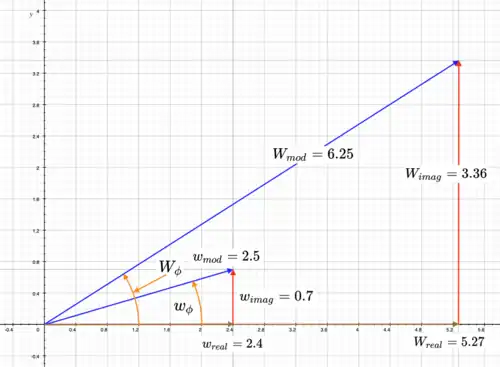Complex square root
Introduction
 Complex number W = complex number w².
Origin at point . parallel to axis. parallel to axis. By cosine double angle formula: Let complex numbers and Let
Similarly, are the corresponding components of are given.
and
|
Implementation
In the python programming language a complex square root is available for floating point numbers with a precision of 15.
# python code:
>>> (5.27 + 3.36*1j) ** 0.5
(2.4+0.7000000000000001j)
>>>
>>> (-18j) ** .5
(3-2.9999999999999996j)
>>>
Function cmath.sqrt() provides clean output:
# python code:
>>> import cmath
>>> cmath.sqrt (5.27 + 3.36*1j)
(2.4+0.7j)
>>> cmath.sqrt (-18j)
(3-3j)
>>>
If it is desired to calculate complex square root with precision greater than that available for python's floating point math,
the following code using python's decimal module will do the job. The following code also shows how complex square root
is calculated.
# python code:
import decimal
dD = decimal.Decimal
dgt = decimal.getcontext()
Precision = dgt.prec = 100 # Adjust as necessary.
def ComplexSquareRoot (v1, v2 = None) :
'''
p,q = ComplexSquareRoot (a,b) or
p,q = ComplexSquareRoot ((a,b))
a,b are the real and imaginary parts of complex number W = (a+bi)
p,q are the real and imaginary parts of complex number w = (p+qi)
where W = w ** 2
This function preserves +/- 0 as calculated by python function cmath.sqrt().
'''
thisName = 'ComplexSquareRoot (v1, v2 = None) :'
if v2 == None : a,b = v1
else : a,b = v1,v2
dgt.prec += 3
a,b = [ dD(str(v)) for v in (a,b) ]
if b == 0 :
if a == 0 : p,q = dD(0),b
else :
root = abs(a).sqrt()
if a > 0: p,q = root, b
else : p,q = dD(0), root.copy_sign(b)
elif a == 0 :
root = abs(b/2).sqrt()
if b > 0 : p,q = root, root
else : p,q = root, -root
else :
Wmod = (a**2 + b**2).sqrt()
wmod = Wmod.sqrt()
cosWφ = a/Wmod
# 2
# cos2A = 2cos A - 1
coswφ = ((cosWφ + 1) / 2).sqrt()
p = wmod * coswφ
q = b /(2*p)
dgt.prec -= 3
return [ s.normalize() for s in (p,q) ]
Examples
# python code:
import cmath
sqrt = cmath.sqrt
for (a,b) in (
(0.,0.), (0.,-0.), (-0.,0.), (-0.,-0.),
(4,0.), (4,-0.), (-4,0.), (-4,-0.),
(0.,50), (0.,-50), (-0.,50), (-0.,-50),
(-394200411798404114010884279663511687236816, 157994206778295991363266285626991662856270),
):
result1 = ComplexSquareRoot (a,b)
result2 = sqrt (complex(a,b))
str1 = 'result1, result2' ; print (str1, eval(str1))
result1, result2 ([Decimal('0'), Decimal('0')], 0j)
result1, result2 ([Decimal('0'), Decimal('-0')], -0j)
result1, result2 ([Decimal('0'), Decimal('0')], 0j)
result1, result2 ([Decimal('0'), Decimal('-0')], -0j)
result1, result2 ([Decimal('2'), Decimal('0')], (2+0j))
result1, result2 ([Decimal('2'), Decimal('-0')], (2-0j))
result1, result2 ([Decimal('0'), Decimal('2')], 2j)
result1, result2 ([Decimal('0'), Decimal('-2')], -2j)
result1, result2 ([Decimal('5'), Decimal('5')], (5+5j))
result1, result2 ([Decimal('5'), Decimal('-5')], (5-5j))
result1, result2 ([Decimal('5'), Decimal('5')], (5+5j))
result1, result2 ([Decimal('5'), Decimal('-5')], (5-5j))
# Function ComplexSquareRoot() preserves precision of large numbers:
result1, result2 ([Decimal('123456789012345678935'), Decimal('639876543210987654321')], (1.2345678901234568e+20+6.398765432109876e+20j))Method #2. Algebraic
Introduction
Let and
Let
Then:
where
Square where
From
From
From
Implementation
# python code:
def ComplexSquareRoot_al (v1, v2=None) :
'''
ComplexSquareRoot algebraic
p, q = ComplexSquareRoot_al (a, b)
'''
if v2 == None : a,b = v1
else : a,b = v1,v2
if 0 in (a,b) : return ComplexSquareRoot (a,b)
dgt.prec += 3
a,b = [ dD(str(v)) for v in (a,b) ]
Wmod = (a**2 + b**2).sqrt()
P1 = (a+Wmod)/2
# P1 must be > 0.
p = P1.sqrt() ; q = b / (2*p)
dgt.prec -= 3
return [ s.normalize() for s in (p,q) ]
|
Because function |
Links to related topics
The Python Standard Library: cmath.sqrt